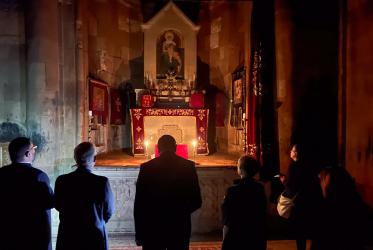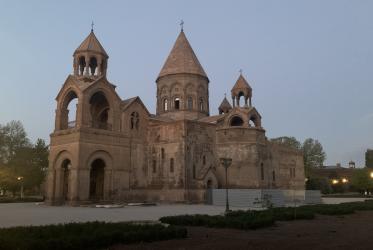Armenian Apostolic Church (Mother See of Holy Etchmiadzin)
Note about membership:
Distribution of membership:
Armenia: 3,026,000
Europe: 3,695,000 (including Russia and the other countries of the former
Soviet Union)
North America: 1,190,000
Latin America: 112,000
According to sacred tradition, in the 1st century the apostles St Thaddeus and St Bartholomew came to Armenia, preached the gospel and were martyred for their faith. From that time onward, there have been Christian communities in Armenia. In 301, Christianity was proclaimed the official state religion. The historical centre of this autocephalous national church is the Mother See of Etchmiadzin, near the capital city of Yerevan. Doctrinally, the church bases its faith on the Bible, holy Tradition, and on the decisions of the first three ecumenical councils. On the question of Christology, it accepts the definition set by the Council of Ephesus, that "one is the nature of the incarnate word". It does not accept the Council of Chalcedon (451), and renounces the teachings of Nestorius and Eutyches. The church's liturgy is substantially that of St Basil the Great, in classical Armenian. The Gregorian calendar is primarily used. The Bible was translated into Armenian at the beginning of the 5th century, immediately after the creation of the Armenian alphabet, which is still in use today.
Holy Etchmiadzin and other monastic centres have contributed to the advancement of faith, culture, literature, science and the arts for centuries. They represent the religious, linguistic and cultural unity of Armenians in their homeland and abroad. During the last decades many sanctuaries, old monasteries and churches have been renovated. There are currently 18 monasteries. As a result of the historical situation of the Armenians, two patriarchates were established within the hierarchy of the Armenian Church, in Jerusalem and Constantinople, both with local jurisdiction. At present over three million Armenians live in the Republic of Armenia, more than two million in Russia and the other republics of the former Soviet Union, and another three million in the diaspora. During the last ten years, 16 new bishops have been consecrated, 63 celibate priests and over 100 married priests have been ordained, and hundreds of deacons have graduated from the Gevorkian Theological Seminary located at the Mother See of Holy Etchmiadzin. In recent years, the number of believers has considerably increased. Among the principal priorities of the Armenian Apostolic Church in the near future are: (a) the spiritual life of Armenians and the sustenance of newly formed parishes and communities; (b) reorganization of the theological seminaries - two new seminaries have been founded; (c) construction and renovation of new churches, (d) development of church media agencies and advancement of Christian education; and (e) the continuation of ecumenical dialogue and visitation with sister churches and other member churches of the WCC.
A new Armenian translation of the Bible was published in 1994. Armed forces chaplaincy and prison ministry programmes were established in the late 1990s. In 2002, at the proposal of the church, the government agreed to add the subject of "Armenian Church History" to the curriculum of the public schools system. A TV studio was founded in 1998, and was granted a licence for a public broadcast in 2002. The studio produces and shows thematic films and documentaries and covers public, economic, cultural, and national-ecclesiastical events as well as church activities. Youth centres were started in 1993 and are spread throughout Armenia providing the youth with places for learning, social and cultural activities. In 1997, the Christian Armenia newspaper was established, a bi-weekly periodical distributed to the local public. The Mother See is a quarterly English language newsletter published and distributed to the diaspora by the department of information services.





